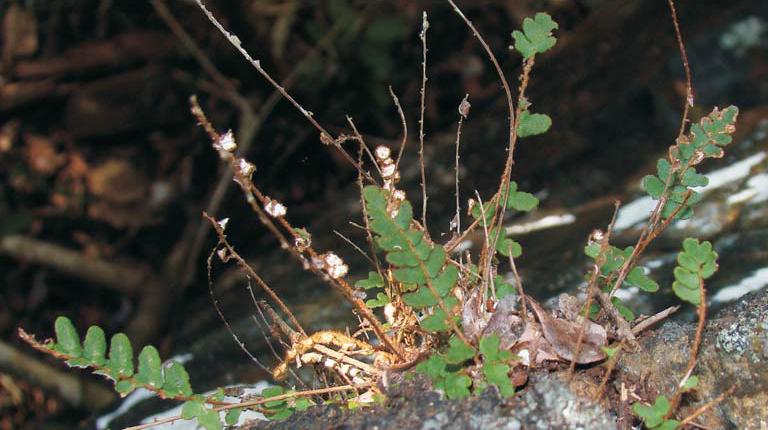Ledis Regalado Gabancho
The aim of this project is to improve the knowledge of ferns and lycophytes within Sierra de Cajálbana, highlighting on distribution of endangered, invasive and expansive species.

Notholaena ekmanii, endemic threatened fern rediscovered after 57 years since it was last seen in the Sierra de Cajálbana, La Palma, Pinar del Río. ©R. Núñez.
Ferns and lycophytes are traditionally poorly studied in Cuba and less considered in floristic studies even though Cuba has about 650 species distributed in all sort of vegetation types. Within the Protected Area Mil Cumbres, in Western Cuba, the highland Sierra de Cajálbana can be found, which is an old serpentine flat hilltop with deep valleys and steep slopes of about 60 km2, with a very rich flora.
An assessment of fern and lycophyte records from Cuban herbaria reveals the scarcity of well documented and updated records of this group of plants in this area, where it can be found endemic and threatened species non recorded after 1950´s and, on the other hand, expansive species which commonly increases their occupation area after disturbances in natural ecosystems. In the last years, Cajálbana has suffered fires and hurricanes, with severe impact to their vegetation. This group of plants is not considered in present plans for management and conservation of resources within this protected area.
The aim of this project is to contribute to conservation efforts in Protected Area Mil Cumbres by improving the knowledge of ferns and lycophytes of Sierra de Cajálbana. We plan to provide an updated inventory of ferns and lycophytes of this area for vegetation sort: cliff evergreen shrub woods, pines forests and wet coniferous gallery forests, relocating endemic species and selecting one invasive and one expansive species to be studied. We will prepare an identification guide with pictures of species for the protected area staff and give them training on identification techniques, emphasizing on important characters.
Data gathered on endangered species biology, distribution and structure of their sporophyte populations will serve as baseline information for initiating species conservation management plans. Collection of ecological data of endemic and endangered ferns from direct observation and population counts will be made.
We will also document the updated distribution in Sierra de Cajálbana of one expansive and one invasive selected fern species by producing GIS maps as a diagnostic of infested surfaces to provide useful information for prioritizing management strategies of specific habitats and species within this area and for designing future long term studies.